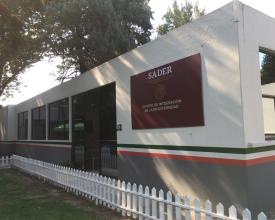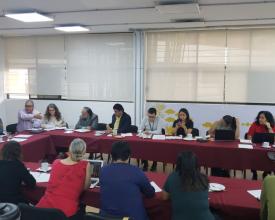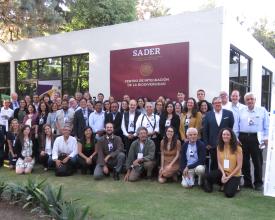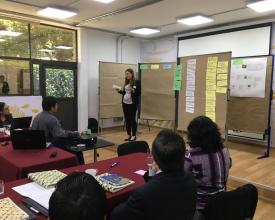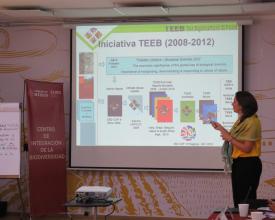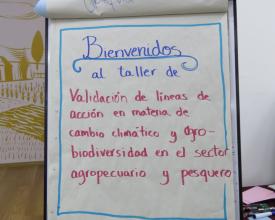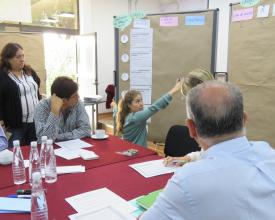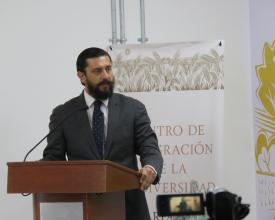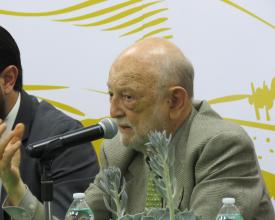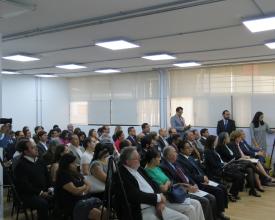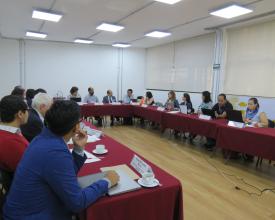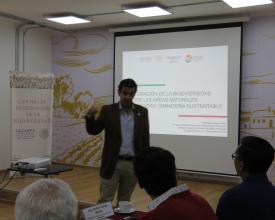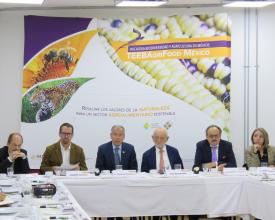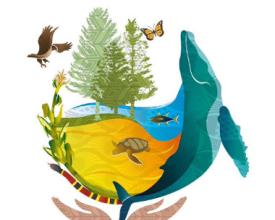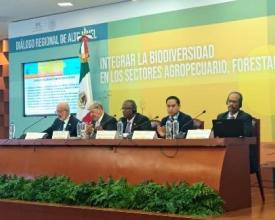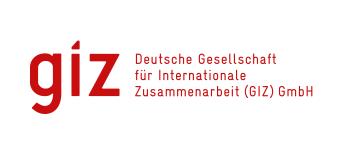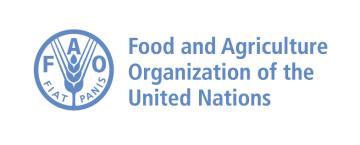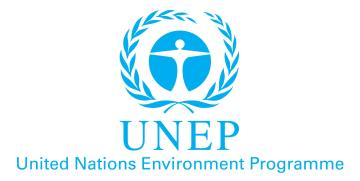
Center for the Integration of Biodiversity, a space for constructive dialogue
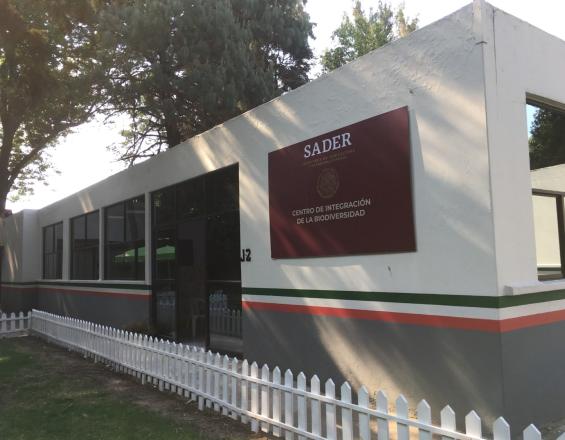
With support from the IKI IBA project, the integration of biodiversity in the agricultural sector was made visible through the opening of the Center for the Integration of Biodiversity in Agriculture (CIB). The CIB aims to promote exchanges between the different sectors (environmental and agricultural, among others) that contribute to the sustainable development of the agricultural sector. The IBC has also contributed to the preparation of several biodiversity integration projects, as well as to the construction of important governmental strategies such as the National Strategy for the Conservation and Sustainable Use of Pollinators (ENCUSP). It has also provided services for multiple trainings on sustainable agriculture and soil degradation assessment, among others. The Center is under the General Directorate of Policy, Foresight and Climate Change of the Ministry of Agriculture and Rural Development.
Context
Challenges addressed
Environmental challenges
- Over the last 30 years, agriculture in Mexico has been inadequately managing soils and crops, which, together with the excessive use of agrochemicals, has led to the disruption of the various natural cycles and affected biodiversity.
Economic challenges
- Agricultural sector policies have favored monocultures and thus favored large-scale producers, further widening the gap between small producers and industrial producers.
- It has generated greater dependence on agricultural inputs and implements, from agrochemicals to improved seeds, thus obstructing the conservation of the genetic resources of native varieties.
Policy challenges
- Maintain the issue of biodiversity mainstreaming in the political will and help the sector to implement it.
- To join efforts with relevant stakeholders and build alliances between the public sector, private sector and civil society organizations, as well as with universities and marketers.
Location
Process
Summary of the process
The political will of the agricultural sector to make the necessary changes to achieve its sustainability objectives is one of the most important factors that allowed the existence of the Biodiversity Integration Center. This allowed for the designation of an appropriate space within the facilities of the Ministry of Agriculture, which sends a powerful message about the seriousness with which the sector approaches the issue, as well as the necessary steps to trigger successful intersectoral coordination processes, even on issues where each sector has very different positions. This intersectoral collaboration also helps to create synergies to optimize resources for specific actions aimed at the conservation and sustainable use of biodiversity. In the case of the IBC, the fulfillment of international commitments has served as an anchor for the initiative, and as a framework to guide both intersectoral coordination and actions within each sector driven by the political will of the sectors to fulfill those commitments.
Building Blocks
Political Will
The Secretariat of Agriculture and Rural Development is strongly committed to achieving sustainability in the sector, as expressed in the Sectoral Program for Agriculture and Rural Development and its mandate to make progress in ending hunger, achieving food security and improving nutrition and promoting sustainable agriculture, which are goals set out in Sustainable Development Goal 2 of the 2030 Agenda approved by the United Nations, which this Secretariat is responsible for implementing and monitoring. The Biodiversity Integration Center responds to the actions for the fulfillment of Objective 3 of the Sector Program: To increase sustainable production practices in the agricultural and aquaculture-fishery sector in the face of agro-climatic risks.
Enabling factors
- There is a clear and defined mandate from the federal government for the agricultural sector to address the risks to food production posed by the global climate crisis, the degradation of ecosystem services and the deterioration of biodiversity.
- There is a real interest on the part of high-level officials in the sector in the issue of sustainability in agricultural production and in finding solutions to the problem of the sector's impact on biodiversity and ecosystem services.
Lesson learned
- A genuine interest of the sector in the issue of sustainability of productive processes is indispensable to facilitate the establishment of a space dedicated exclusively to this purpose. For example, the management of the facilities currently occupied by the IBC within the Ministry of Agriculture was largely facilitated by the sector's willingness to fulfill the commitments acquired with the Project for the Integration of Biodiversity in Mexican Agriculture.
Intersectoral Coordination
Sustainability objectives for productive processes cannot be met by a single institution or person; they necessarily involve the coordination of a large number of actors and sectors in order to be successful. Having a space dedicated to the issue of biodiversity integration helps to promote the intersectoral dialogue necessary to find comprehensive solutions to complex problems, so the Biodiversity Integration Center is proposed as a space for intersectoral coordination that contributes to the fulfillment of the SDGs of the 2030 Agenda and where the different instances are supported to strengthen the planning instruments, strategies and programs of government institutions, generating benefits related to poverty alleviation, food security and sovereignty and adaptation to climate change, among other aspects.
Enabling factors
- The need for the different sectors to establish synergies to achieve the federal government's priority objectives.
- The signing of an implementation agreement within the framework of the IKI IBA Project, where both the agricultural and environmental sectors committed to collaborate in the implementation of this project.
Lesson learned
- The role of the Center is of great relevance for capacity building of the different actors involved in the sector, as well as to serve as an information center to be used as a tool for the design and monitoring of policies and programs that integrate the issue of conservation and sustainable use of biodiversity in the Sector. This is only possible if AGRICULTURE and ENVIRONMENT work in a coordinated manner.
Fulfillment of international commitments
In the framework of the COP13 of the Convention on Biological Diversity held in December 2016 in Mexico, CONABIO, the German Cooperation Agency (GIZ) and the Biodiversity Finance Initiative (BIOFIN-Mexico) developed together with the agricultural, forestry, fisheries and tourism sectors, the Strategies for the Integration and Sustainable Use of Biodiversity, These Strategies set out the strategic lines of action that will guide their actions in the short, medium and long term to achieve a sustainable use of biodiversity, contributing to its conservation and guaranteeing the wellbeing of future generations through the adequate management of ecosystem goods and services. It is within the framework of this effort that the Biodiversity Integration Center is established.
Enabling factors
- The Mexican federal government's commitment to meeting the Sustainable Development Goals of the 2030 Agenda.
- The impetus given by the COP 13 held in Cancun, Mexico, to the issue of integrating biodiversity for wellbeing, focusing on specific productive sectors.
Lesson learned
- The fact that the IBC is anchored in the fulfillment of international commitments, such as the SDGs of the 2030 Agenda, has greatly contributed to the consolidation of the IBC as an intersectoral space.
Resources
Impacts
- Institutional recognition of the importance of biodiversity integration.
- Space for the discussion of various topics that require intersectoral attention, such as pollinator conservation, soil conservation, and the effects of agriculture on climate change, among others.
- Training center (capacity 50 people) on sustainable agriculture, value chains, visibility and valuation of biodiversity and ecosystem services.
- Space for comprehensive discussion of climate change and biodiversity, biodiversity in the health and wellbeing of the population.
- Promotion of actions aimed at achieving Objective 3 of the Sectoral Program for Agriculture and Rural Development, through the General Directorate for Policy, Foresight and Climate Change.
Beneficiaries
- Small and medium-sized producers, as well as consumers interested in supporting good sustainable agricultural practices.
- Officials interested in generating innovative policies that integrate biodiversity.

